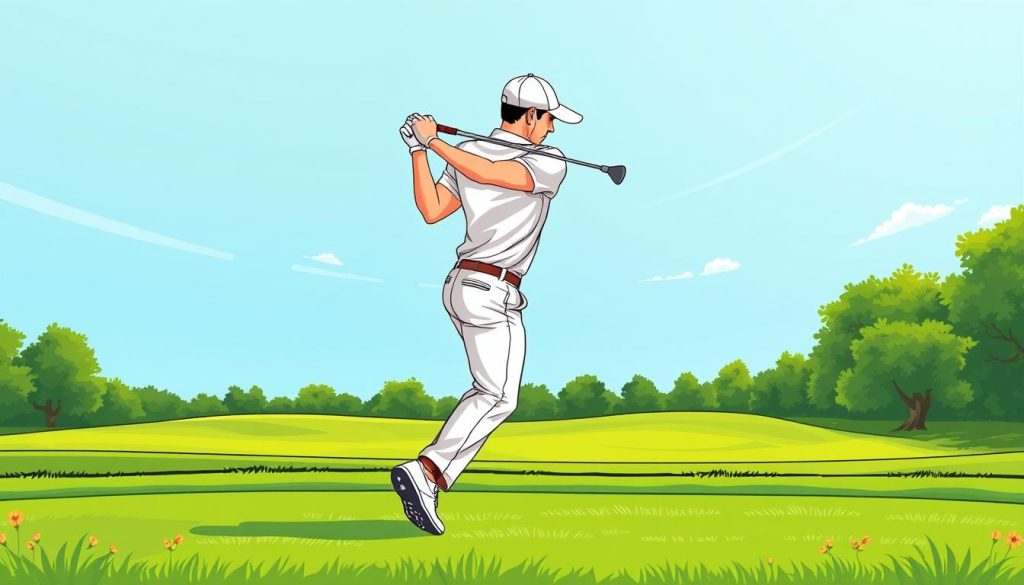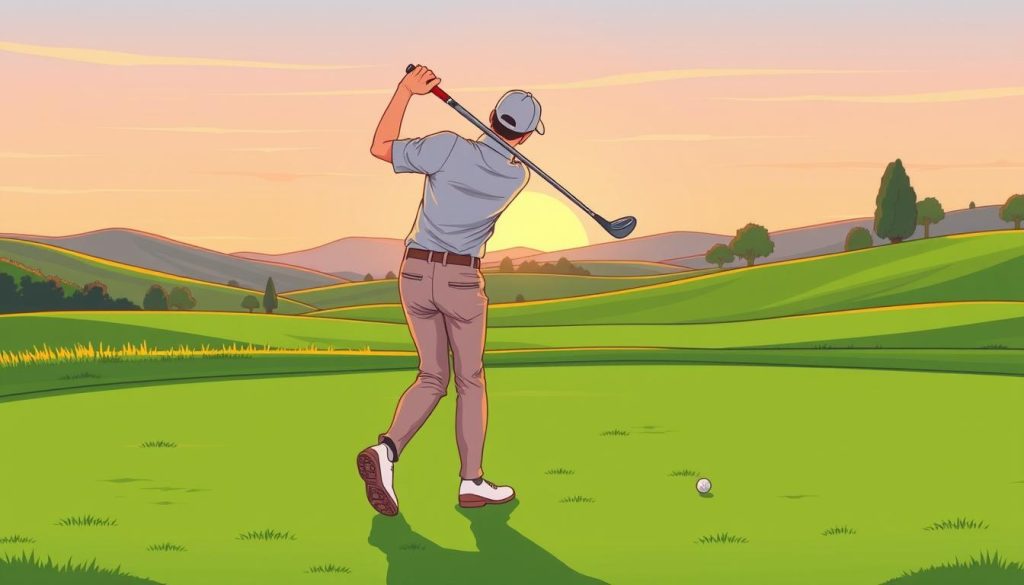Your golf swing follow-through is key to consistent and accurate shots. It extends your arms, rotates your body, and shifts weight to your leading foot. Perfecting your follow-through boosts clubhead speed and distance, keeping your shots clean and straight.
A proper follow-through is more than just looking good after the ball leaves. It’s vital for shot accuracy and performance. Focus on your follow-through to improve your swing’s fluidity and balance.
Key Takeaways
- Follow-through maximizes distance and controls shot direction
- Maintain balance during the swing for better results
- Allow arms to continue stretching around the body in the downswing
- Rotate hips and extend arms through the shot
- Achieve full body rotation after impact for power and balance
- Check hand position, shoulder alignment, and head position
- Finish with hands high and right shoulder lower than left
Understanding the Golf Swing Follow-through Fundamentals
The follow-through in golf is more than just a finishing pose. It’s a key part of your swing that affects accuracy, distance, and consistency. Let’s explore the essential elements of a good follow-through.
The Role of Follow-through in Shot Accuracy
A smooth follow-through keeps your clubhead speed consistent. This leads to better shot accuracy and distance. It also keeps your swing path on track, guiding the ball to your target.
By doing drills like impact bag exercises, you can improve your technique. This boosts your performance on the course.
Impact Position and Body Movement
At impact, your body should be strong. Your arms should be fully extended, with your right shoulder lower than your left if you’re right-handed. As you move through impact, focus on rotating your hips and shoulders to face the target.
Weight Transfer Dynamics
Proper weight transfer is crucial for a good follow-through. As you finish your swing, move your weight onto your leading foot. This should be smooth and controlled, keeping you balanced.
A stable finish shows good weight distribution. This leads to more consistent shots.
| Follow-through Component | Benefit |
|---|---|
| Fluid motion | Consistent clubhead speed |
| Proper body rotation | Increased power and control |
| Smooth weight transfer | Better balance and stability |
Remember, your follow-through is a diagnostic tool. It can show swing issues, like improper weight shift or arm problems. By focusing on these basics, you’ll get a more efficient and powerful golf swing. A smooth and controlled follow-through often reflects a well-executed swing, while a forced or awkward finish could signal areas needing attention. To address these, consider incorporating golf swing transition tips into your practice, as they can help you link the backswing and downswing more seamlessly. By refining this critical aspect, you’ll enhance timing, balance, and overall consistency in your golf swing.
Golf Swing Follow-through Guide
A proper golf swing follow-through is key for accuracy and power. Knowing the essential parts and avoiding common mistakes can greatly improve your game. Let’s look at the main elements of a good follow-through and learn from the pros.
Essential Components of Proper Follow-through
Mastering the follow-through means perfecting several swing mechanics. The release point, club rotation, and balance are all crucial for a successful shot. Here are the main components:
- Weight transfer: Shift about 80% of your weight to your front foot
- Body rotation: Turn your chest toward the target line
- Club position: Finish with the club behind your head or shoulders
- Balance: Maintain a stable stance throughout the swing
Common Follow-through Mistakes
Avoiding these errors can improve your swing mechanics:
- Stopping the swing short
- Poor weight transfer
- Incorrect club face position at impact
- Losing balance during the follow-through
Professional Techniques and Tips
Try these expert-recommended drills to perfect your follow-through:
- Two-club drill: Use two golf clubs to visualize your swing path
- Squeeze-the-knees exercise: Improve balance and weight transfer
- HackMotion wrist drill: Correct clubface positioning at impact
- Alignment drill: Set up parallel to the target and practice extension
- Pitching wedge drill: Focus on weight transfer and forward shaft lean
| Follow-through Component | Correct Technique | Common Mistake |
|---|---|---|
| Weight Distribution | 80% on front foot | Equal weight on both feet |
| Back Heel Position | Raised in the air | Planted on the ground |
| Club Finish Position | Behind head or shoulders | Stopping short or too low |
| Body Rotation | Chest facing target | Incomplete rotation |
| Balance | Stable and controlled | Swaying or falling off-balance |
The Physics Behind an Effective Follow-through
Understanding the physics of golf swing follow-through is key to improving your game. The follow-through affects the golf ball’s path, club speed, momentum, and force. Let’s explore the science behind a perfect follow-through.
Golf is a popular sport with about 55 million regular players worldwide. To master the game, knowing the mechanics of each swing phase is crucial. The golf swing has four main phases: address, backswing, downswing, and follow-through. Each phase can be broken down into sub-phases based on nine specific events.
Clubhead Speed and Momentum
An effective follow-through ensures consistent clubhead speed, which is vital for achieving greater distance. The club should reach its maximum speed at impact, thanks to a fluid and complete follow-through. This momentum transfer from the club to the ball greatly affects the golf ball’s trajectory.
Force and Balance
The follow-through helps maintain balance throughout the swing, which is key for a clean and straight shot. Proper weight distribution during the follow-through is essential. At impact, your weight should be over the left ankle (for right-handed golfers), allowing smooth body rotation at the hip.
| Swing Phase | Key Physics Concept | Impact on Shot |
|---|---|---|
| Backswing | Potential Energy | Power Generation |
| Downswing | Kinetic Energy | Clubhead Speed |
| Follow-through | Momentum Transfer | Ball Trajectory |
By understanding and applying these physics principles, you can improve your golf swing follow-through and reduce injury risk. Remember, staying outside neutral joint alignment during your swing can strain joints and lead to injuries. Focus on maintaining proper spine angle and keeping your hands in front of your chest for a masterful follow-through.
Mastering Body Position and Balance
Getting your golf swing right means mastering body position and balance. A strong base leads to steady shots and better play. Let’s look at what makes a balanced swing.
Proper Weight Distribution
Weight transfer is key in your golf swing. Begin with your weight split evenly between both feet. As you swing, move 80% of your weight to your front foot by the end. This move boosts power and accuracy in your shots.
Hip and Shoulder Rotation
Body rotation is vital for a strong and precise swing. Your hips and shoulders should turn together, pointing towards your target after hitting the ball. This rotation builds torque, speeding up your clubhead and extending your shot.
Maintaining Spine Angle
Keeping a steady spine angle is crucial for consistent swings. Bend from your hips, keeping your back straight and knees slightly bent. This stance helps your swing rotate smoothly and stay balanced.
| Element | Importance | Common Mistake |
|---|---|---|
| Weight Transfer | Generates power and accuracy | Remaining flat-footed |
| Body Rotation | Increases clubhead speed | Over-rotating upper body |
| Spine Angle | Ensures consistency | Swaying or lifting during swing |
At the end, your back heel should lift off the ground, with just your back toe touching. This shows you’ve transferred your weight correctly and balanced well. Work on these points to make your golf swing more stable and powerful.

Club Position and Release Point
Mastering club face control, release point, and follow-through direction is crucial for improving your golf swing. These elements work together to determine the accuracy and power of your shots.
Club Face Control Through Impact
Club face control is vital for shot direction. At impact, aim for a square clubface with a slight forward shaft lean. This position helps generate lag and stored energy in the club. Remember, 80% of efficient release techniques involve rotation rather than flipping or body turning.
Optimal Release Timing
The release point occurs just after impact when your arms fully extend. Timing is key here. Golf experts suggest that 70% of amateur golfers struggle with proper club release technique. To improve, focus on maintaining proper wrist angles through impact. This allows your body to rotate naturally, encouraging a square face at impact.
| Swing Position | Key Focus |
|---|---|
| P6 (Pre-impact) | Generate lag, store energy |
| P7 (Impact) | Square clubface, forward shaft lean |
| P8 (Release) | Arm extension, weight transfer |
Follow-through Height and Direction
Your follow-through direction greatly influences shot trajectory. Aim for the club to finish behind your head and shoulders, with hands at or above shoulder height. The clubhead should end up on the opposite side of your upper body from your hands. About 60% of golfers tend to add loft to the club through impact due to improper release, affecting their follow-through direction.
Practice these techniques to improve your club position and release point. Remember, consistency is key. With time, you’ll see improvements in your shot accuracy and distance.
Building Consistency in Your Follow-through
Golf swing consistency is key for improving your game. Mastering your follow-through is crucial. Let’s look at how to make your follow-through reliable and consistent, boosting your game on the course.
Consistency begins with understanding the basics. Your follow-through should feel natural, not forced. Many golfers try to control the club manually, leading to inconsistent shots.

Practice drills are vital for muscle memory. Focus on exercises that promote proper body rotation and controlled club movements. A good drill is moving your arms while keeping posture and balance right. This helps you feel a smooth, consistent swing.
Repetition is crucial. Practice these motions until they feel natural. It’s about feeling the right movements, not just following instructions.
| Aspect | Amateur Golfers | Professional Golfers |
|---|---|---|
| Swing Duration | 1.5 – 3.0 seconds | About 1 second |
| Backswing to Downswing Ratio | Often inconsistent | Approximately 3:1 |
| Posture Maintenance | Often changes mid-swing | Consistent throughout |
To achieve consistency, create a system for practice and play. Use a “technical box” for mechanics practice, then focus on targets on the course. This approach reduces overthinking and lets muscle memory guide you during play.
Advanced Follow-through Techniques for Shot Shaping
Shot shaping is key for golfers wanting to improve. The follow-through affects your ball’s flight. Learn to master draw and fade shots and adjust for different clubs.
Draw and Fade Follow-through Variations
To shape shots well, adjust your follow-through. For a draw, wrap your follow-through around your body. This leads to a right-to-left curve for right-handed golfers.
For a fade, keep your follow-through upright. This creates a left-to-right ball flight.
Adjusting for Different Club Types
Your follow-through changes with club selection. Longer clubs like drivers need a full follow-through for distance. Shorter clubs, like wedges, require a compact follow-through for control.
Practice these variations to enhance your shot shaping skills. This will improve your game with every club.
| Club Type | Follow-through Characteristic | Shot Shape Focus |
|---|---|---|
| Driver | Full, extended | Draw or fade for accuracy |
| Fairway Woods | Long, sweeping | Slight draw for distance |
| Long Irons | Three-quarter length | Straight or slight fade |
| Short Irons | Compact, controlled | Precise draw or fade |
| Wedges | Abbreviated, hands low | Subtle shapes for control |
Mastering these techniques takes time and practice. Focus on balance and control in your swing. With effort, you’ll shape shots like a pro, ready for any course challenge.
Common Follow-through Problems and Solutions
Golf swing follow-through issues can really mess up your game. Let’s look at some common problems and how to solve them. This will help you hit better shots.
Early Release Issues
Many golfers face early release, leading to less power and accuracy. To fix this, keep your wrists hinged during impact. Practice drills that help you keep lag in your downswing.
Use a tool like the HackMotion to check your wrist position. This will help you improve.
Balance Problems
Balance issues often come from bad weight distribution or swinging too hard. Work on keeping your lower body stable during your swing. Practice ending in a balanced stance, with most of your weight on your front foot.
Remember, over 60% of your weight should be on your lead foot at the end.
Tempo Corrections
Swing tempo is key for consistent play. A smooth swing leads to better contact and accuracy. Try using a 3:1 tempo ratio – three counts for your backswing and one for your downswing.
Use rhythm drills or a metronome app to get your swing tempo right.
A good follow-through starts with a solid base. Pay attention to your stance, grip, and posture. Aim for a neutral grip with pressure around 4-5 on a scale of 1-10.
Focus on rotation, not extension, in your backswing. By tackling these common issues, you’ll improve your golf swing.
Practice Drills for Perfect Follow-through
Mastering your golf swing follow-through is key for better shots. Let’s look at some drills to improve your follow-through.
Two-Club Follow-through Drill
This drill helps you feel the momentum for a full finish. Hold two clubs together and swing. Make sure both clubs point towards the ground behind you.
This exercise focuses on clubhead speed and position at the end of your swing.
Squeeze the Knees Exercise
The squeeze-the-knees drill improves hip rotation and weight transfer. As you swing, imagine squeezing your knees together. This helps balance and ensures your hips release correctly at impact.
It’s a simple yet effective way to refine your follow-through mechanics.
Balance and Extension Drills
Maintaining stability and achieving full extension are crucial for a good follow-through. Practice swinging while standing on one foot to improve balance. Focus on fully stretching your arms after impact.
These swing practice routines will help you develop a more fluid and controlled follow-through.
Incorporate these follow-through exercises into your regular practice sessions. Remember, consistent practice is essential for improvement. As you work on these drills, you’ll develop muscle memory for proper technique.
This will lead to more accurate and powerful shots on the course.
| Drill | Focus Area | Benefits |
|---|---|---|
| Two-Club Follow-through | Clubhead Speed and Position | Improved Momentum and Finish |
| Squeeze the Knees | Hip Rotation and Weight Transfer | Enhanced Balance and Hip Release |
| Balance and Extension | Stability and Arm Extension | Fluid and Controlled Follow-through |
Equipment Considerations for Optimal Follow-through
Your golf equipment is key to a perfect follow-through. Getting your clubs fitted just right is crucial. It makes your swing better and follow-through smoother.
Shaft flex is very important. The right flex helps your timing and release. A stiff shaft can make it hard to extend fully. A too flexible shaft can cause inconsistent hits and follow-through.
Club weight also matters a lot. Heavier clubs help keep momentum, leading to a stronger follow-through. Lighter clubs might speed up your swing but can make the follow-through feel off.
Think about these when picking your gear:
- Club length: It affects your posture and balance in the follow-through
- Grip size: It changes how your hands are positioned and release
- Clubhead design: It affects the club’s path and follow-through
Remember, fitting your clubs isn’t just for beginners. As you get better, your clubs might need to change too. Regular fittings help your clubs keep up with your improving swing, including the follow-through.
Conclusion
Mastering the golf swing follow-through is key for better golf. While most articles focus on the start, the finish is just as important. Professional golfers keep their lead foot firm, move their hips, and face the target.
They reach speeds of 113 mph with drivers. This shows how crucial the follow-through is. It tells you if your swing is balanced and if you’re transferring weight right.
Common mistakes like early extension or too much rotation can harm your game. To fix this, aim for a controlled finish. Keep your arms straight and wrists in the right position.
Adding practice tips to your routine can really help. Try using tools like the “Lag Shot” for quick feedback. Remember, the right grip is vital, especially for those with larger hands.
By focusing on these areas and practicing regularly, you’ll see big improvements in your game.
FAQ
Why is the golf swing follow-through important?
How does the follow-through affect shot accuracy?
What are the essential components of a proper follow-through?
What are common follow-through mistakes?
How should weight be distributed during the follow-through?
How does club face control affect the follow-through?
How can I improve my follow-through consistency?
How does the follow-through differ for different types of shots?
What are some effective drills for improving follow-through?
How does equipment affect the follow-through?
How does the follow-through impact ball flight?
What role does tempo play in the follow-through?
Source Links
- https://www.rickshiels.com/golf-videos/driver-follow-through-the-complete-driver-golf-guide
- https://golfforbeginnersguide.com/golf-swing-follow-through/
- https://skillest.com/blog/mastering-the-follow-through-in-your-golf-swing/
- https://rotaryswing.com/c4/100-golf-swing-follow-through
- https://nationalgcla.com/the-basics-of-the-golf-swing/
- https://hackmotion.com/golf-follow-through-drills/
- https://theleftrough.com/golf-swing-follow-through/
- https://www.ncbi.nlm.nih.gov/pmc/articles/PMC9227529/
- https://rotaryswing.com/golf-instruction/golfbiomechanics/proper-golf-swing-follow-through
- https://swingfit.net/golf-swing-mechanics/
- https://www.marygrovemustangs.com/perfecting-your-swing-advanced-techniques-for-serious-golfers.html
- https://www.rvcc.com/blog/mastering-your-golf-swing
- https://hackmotion.com/golf-swing-positions/
- https://hackmotion.com/how-to-release-golf-club/
- https://rotaryswing.com/c4/238-5-minutes-to-the-perfect-golf-club-release
- https://www.dannymaude.com/blog/CREATE A CONSISTENT GOLF SWING
- https://www.performancegolf.com/blog/golf-backswing-the-key-to-unlocking-more-golf-swing-consistency?srsltid=AfmBOoqifb4MJQt4i944OGFk7sdBHI2o8kD3eZHtHASmChGFOaeggbQa
- https://clubhouseofspearfish.com/golf-swing-mastery-tips/
- https://golf.com/instruction/3-difficult-golf-practice-shots-mid-handicappers/
- https://hackmotion.com/common-golf-swing-mistakes/
- https://www.golftrainingaids.com/blogs/articles/golf-swing-tips?srsltid=AfmBOorHvgjz0JDyGEd2LAy5mkMHSBVlVqxJCTxPYoc2QOWXVSV4GwRa
- https://www.performforgolf.com/blog/how-to-swing-a-golf-club-the-golf-swing-sequence-slow-motion-golf-swing-video
- https://bam-metrics.com/the-anatomy-of-a-golf-swing-understanding-muscle-engagement-and-mobility/
- https://hackmotion.com/inconsistent-golf-swing/
- https://www.nickadcockgolf.com/new-blog-1/example-post-1-whbgh
- https://skillest.com/blog/a-comprehensive-guide-to-mastering-the-golf-swing/
- https://lilyfieldphysio.com.au/blog/uncategorized/mastering-golf-swing-step-by-step-guide/


